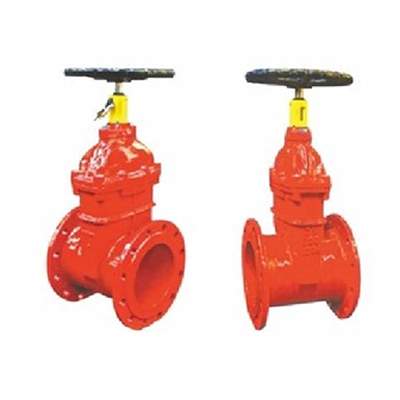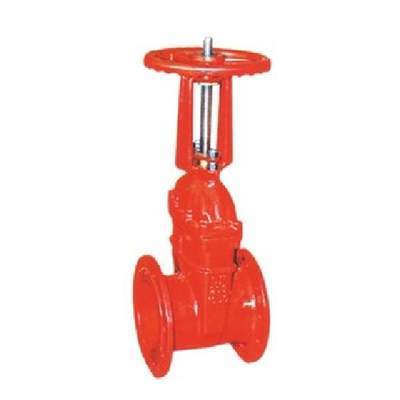Introduction

Fire fighting gate valves are vital components of fire protection systems, serving as reliable control mechanisms for water or other extinguishing agents. Selecting the appropriate gate valve is paramount for ensuring the safety and effectiveness of your fire suppression system. This comprehensive guide will delve into the key factors to consider when choosing the right fire fighting gate valve, providing you with the necessary information to make an informed decision.
Understanding Fire Fighting Gate Valves
A fire fighting gate valve is a specialized valve designed to control the flow of fluids, typically water, in fire protection systems. It operates by lifting a gate or wedge out of the fluid’s path, allowing for complete shutoff when closed. These valves are constructed from materials that can withstand high temperatures and pressures, ensuring their durability and reliability in demanding fire fighting conditions.
Fire fighting gate valves are essential in various settings, including:
- Industrial facilities: Factories, warehouses, and manufacturing plants often require fire protection systems to safeguard against potential fires.
- Commercial buildings: Offices, shopping malls, and hotels utilize fire fighting gate valves to control the flow of water to sprinklers and other fire suppression equipment.
- Residential complexes: Apartments, condominiums, and gated communities may employ fire fighting gate valves in their central fire protection systems.
- Public spaces: Schools, hospitals, and government buildings often have fire protection systems equipped with gate valves to ensure rapid response in case of emergencies.
Types of Fire Fighting Gate Valves
Several types of fire fighting gate valves are available, each with its unique characteristics and applications. Some common types include:
- Wedge gate valves: These valves feature a wedge-shaped gate that is raised or lowered to control the flow of fluid. Wedge gate valves are widely used in fire protection systems due to their simplicity and reliability. They offer good flow characteristics and are suitable for a variety of applications.
- Parallel gate valves: In parallel gate valves, the gate moves parallel to the pipeline, providing a straight flow path when fully open. This design reduces turbulence and pressure loss, making parallel gate valves suitable for high-flow applications. They are often used in large-scale fire protection systems.
- Knife gate valves: These valves are designed for applications where slurries or solids are present in the fluid, and they feature a sharp-edged gate that can cut through these materials. Knife gate valves are less commonly used in fire protection systems but may be necessary in specific situations, such as when dealing with contaminated water sources.
Factors to Consider When Choosing a Fire Fighting Gate Valve
When selecting a fire fighting gate valve, several factors must be considered to ensure optimal performance and safety. These include:
- Material: The valve material should be compatible with the fluid being used and capable of withstanding high temperatures and pressures. Common materials used for fire fighting gate valves include cast iron, ductile iron, stainless steel, and bronze. The choice of material depends on factors such as the fluid’s corrosivity, the operating temperature, and the valve’s intended use.
- Size: The valve size must be appropriate for the pipeline and the flow rate required. The size is typically expressed in nominal pipe size (NPS). It is important to select a valve that is neither too small nor too large to ensure proper operation and prevent excessive pressure loss.
- Pressure rating: The pressure rating of the valve should exceed the maximum operating pressure of the system. Pressure ratings are typically classified according to standards such as ANSI/ASME B16.10. Selecting a valve with an appropriate pressure rating is crucial to prevent leaks and failures under high-pressure conditions.
- Temperature rating: The valve should be able to withstand the maximum temperature of the fluid. Temperature ratings are usually expressed in degrees Fahrenheit or Celsius. It is essential to choose a valve that can handle the temperature extremes that may occur in the fire protection system.
- End connections: The valve end connections must be compatible with the piping system. Common end connections include flanged, threaded, and grooved. Ensure that the valve’s end connections match those of the adjacent pipes to allow for proper installation and sealing.
- Actuation: Fire fighting gate valves can be manually or automatically actuated. The choice of actuation method depends on the specific application and the desired level of automation. Manually operated valves require physical intervention to open or close, while automatically actuated valves can be controlled by remote systems or sensors.
- Certification: Ensure that the valve is certified by recognized testing agencies, such as UL or FM, to meet applicable standards. Certification indicates that the valve has undergone rigorous testing and meets specific performance requirements.
Table: Key Considerations for Fire Fighting Gate Valve Selection
| Factor | Description |
|---|---|
| Material | Cast iron, ductile iron, stainless steel, bronze |
| Size | Nominal pipe size (NPS) |
| Pressure rating | Class 125, 150, 250, 600 |
| Temperature rating | Varies depending on material |
| End connections | Flanged, threaded, grooved |
| Actuation | Manual, electric, pneumatic, hydraulic |
| Certification | UL, FM |
Installation and Maintenance

Proper installation and regular maintenance are crucial to ensure the long-term performance and reliability of fire fighting gate valves. Installation should be carried out by qualified personnel in accordance with the manufacturer’s instructions and applicable codes and standards. Regular inspections, testing, and lubrication are necessary to maintain the valve’s functionality and prevent premature failure.
Conclusion
Selecting the appropriate fire fighting gate valve is a critical decision that can significantly impact the safety and effectiveness of your fire protection system. By carefully considering the factors discussed in this guide, you can choose a valve that meets your specific needs and provides reliable service for many years to come.
FAQ
What is the difference between a fire fighting gate valve and a globe valve?
While both are used in fire protection systems, gate valves are designed for complete shutoff, while globe valves provide more gradual flow control.
How often should fire fighting gate valves be inspected and tested?
The frequency of inspections and testing depends on local regulations and the specific requirements of the fire protection system. However, annual inspections and testing are generally recommended.
What are the common causes of failure in fire fighting gate valves?
Common causes of failure include corrosion, sediment buildup, mechanical damage, and improper maintenance.
Can a fire fighting gate valve be used for other applications?
Yes, fire fighting gate valves can also be used in other applications where reliable flow control is required, such as water supply systems and industrial processes.
What are the latest trends in fire fighting gate valve technology?
Some of the latest trends include the development of valves with advanced materials, improved actuation methods, and enhanced monitoring capabilities.
